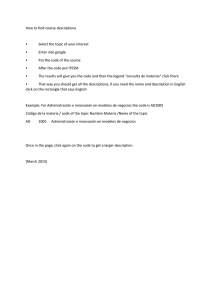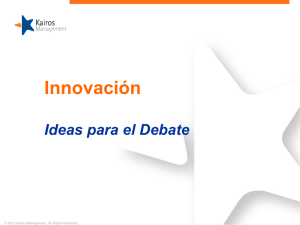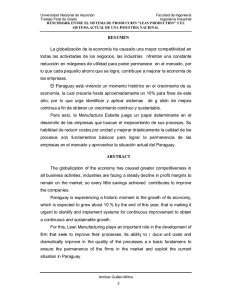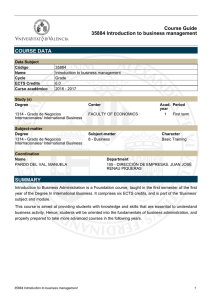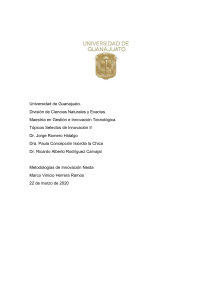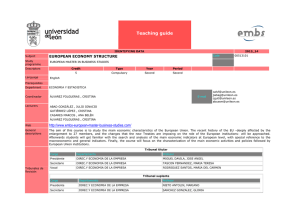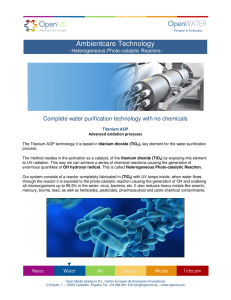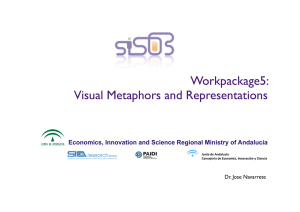SUBJECT TEACHING GUIDE
Anuncio
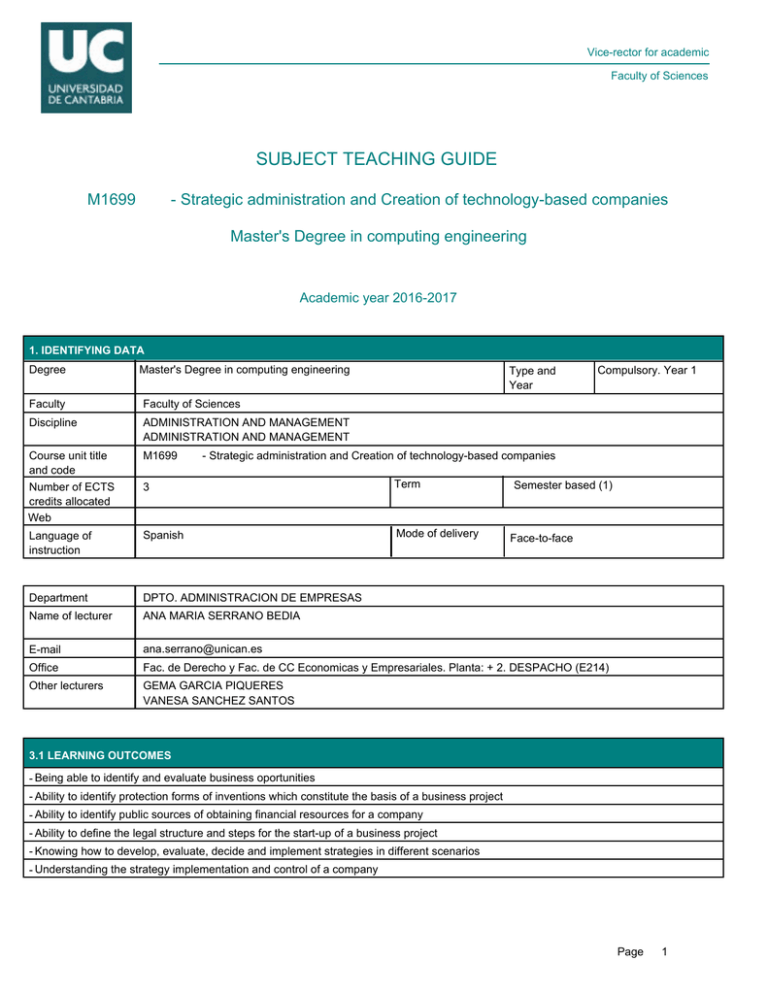
Vice-rector for academic Faculty of Sciences SUBJECT TEACHING GUIDE M1699 - Strategic administration and Creation of technology-based companies Master's Degree in computing engineering Academic year 2016-2017 1. IDENTIFYING DATA Degree Master's Degree in computing engineering Type and Year Compulsory. Year 1 Faculty Faculty of Sciences Discipline ADMINISTRATION AND MANAGEMENT ADMINISTRATION AND MANAGEMENT Course unit title and code M1699 Number of ECTS credits allocated Web 3 Term Language of instruction Spanish Mode of delivery Department DPTO. ADMINISTRACION DE EMPRESAS Name of lecturer ANA MARIA SERRANO BEDIA E-mail [email protected] Office Fac. de Derecho y Fac. de CC Economicas y Empresariales. Planta: + 2. DESPACHO (E214) Other lecturers GEMA GARCIA PIQUERES VANESA SANCHEZ SANTOS - Strategic administration and Creation of technology-based companies Semester based (1) Face-to-face 3.1 LEARNING OUTCOMES - Being able to identify and evaluate business oportunities - Ability to identify protection forms of inventions which constitute the basis of a business project - Ability to identify public sources of obtaining financial resources for a company - Ability to define the legal structure and steps for the start-up of a business project - Knowing how to develop, evaluate, decide and implement strategies in different scenarios - Understanding the strategy implementation and control of a company Page 1 Vice-rector for academic Faculty of Sciences 4. OBJECTIVES Providing students with the knowledge and skills needed to develop a business plan Providing students with the knowledge and skills needed to start up a business Providing students with the knowledge to protect innovations that can constitute the basis of a business plan Providing students with the ability to prepare, manage, evaluate and monitor a complete work to develop an idea into a product or service Providing students with knowledge about the nature, content and functions of strategic management of a company 6. COURSE ORGANIZATION CONTENTS 1 The process of creating a new business: from an idea to an opportunity 2 Business plan 3 Intellectual property rights. 4 Technology-based companies: features, financing, constitution and legalization 5 Innovation strategy: strategic process 7. ASSESSMENT METHODS AND CRITERIA Description Type Final Eval. Reassessment % Oral presentations. Group work Work No Yes 10,00 Written group works Work No Yes 20,00 Written exam Written exam Yes Yes 40,00 Individual works Work No Yes 20,00 Individual oral expositions Work No Yes 10,00 TOTAL 100,00 Observations The subject will be passed by getting at least 5 points in the overall calculation of the proposed activities. There is a single annual evaluation period. If the subject is not passed in the ordinary evaluation activities carried out in the first or the second quarters, an extraordinary evaluation will be available in September. If the maximum number of highest grades (“Matricula de Honor”) is reached in the ordinary evaluation period, students following the extraordinary evaluation will not be eligible to this grade. Observations for part-time students Part-time students can overcome the subject by conducting a written exam (60% of the overall qualification) and the completion and submission of an individual work about any of the topics covered in the course (the remaining 40%). To overcome the subject it is necessary an overall rating of at least 5 points in the set of proposed activities. Page 2 Vice-rector for academic Faculty of Sciences 8. BIBLIOGRAPHY AND TEACHING MATERIALS BASIC ALEMANY, L. (2003): "Venture capital: valoración de empresas de nueva creación”, Iniciativa emprendedora y empresa familiar, Nº. 40. BREALEY, R.; MYERS, S. y ALLEN, F. (2006): Principios de finanzas corporativas. 8ª edición – McGraw- Hill. GENESCA, E., URBANO, D., CAPELLERAS, J. L. GUALLARTE,C. Y VERGES, J. (Coords.) (2003): Creación de empresas. Universitat Autónoma de Barcelona FERNÁNDEZ SÁNCHEZ, E. (2005): Estrategia de Innovación. Thomson Paraninfo, S.A. GIL ESTALLO, M.A. y GINER DE LA FUENTE (2010): Cómo crear y hacer funcionar una empresa. Esic HIDALGO NUCHERA, A.; LEÓN SERRANO, G.; PAVÓN MOROTE, J. (2002): La gestión de la innovación y la tecnología en las organizaciones. Pirámide. LOPEZ MIELGO, N.; MONTES PEÓN, J. M.; VAZQUEZ ORDÁS, C. J. (2007): Cómo gestionar la innovación en las PYMES. Netbiblio. MERINO, C. y VILLAR, L. (2007): “Factores de éxito en los procesos de creación de empresas de base tecnológica”. Economía Industrial, nº 366, pp. 147-167. METRICK, A. (2006): Venture Capital and the Finance of Innovation. Wiley. MOYANO, J., BRUQUE, S., MAQUEIRA, J.M. Y MARTINEZ, P.J. (2010): Gestión de la calidad en empresas tecnológicas. De TQM a ITIL. Starbook OEPM (2007): Cuestiones básicas acerca de patentes y modelos de utilidad. Oficina Española de Patentes y Marcas. Madrid. PELEGRÍN FERNÁNDEZ LÓPEZ, CARLOS; MARTÍNEZ CARMONA, JUAN MANUEL (2003): “El Proceso de Formación en una Empresa Tecnológica”. Revista Madri+d, nº 15. SILVA DUARTE, J.E. (2009): Emprendedor. Crear su propia empresa. Starbook SCHNARCH, A. (2010): Creatividad aplicada. Starbook. VALDERRAMA, B. (2013): Creatividad inteligente. Guía para convertir ideas en innovación. Pearson Educación Page 3

